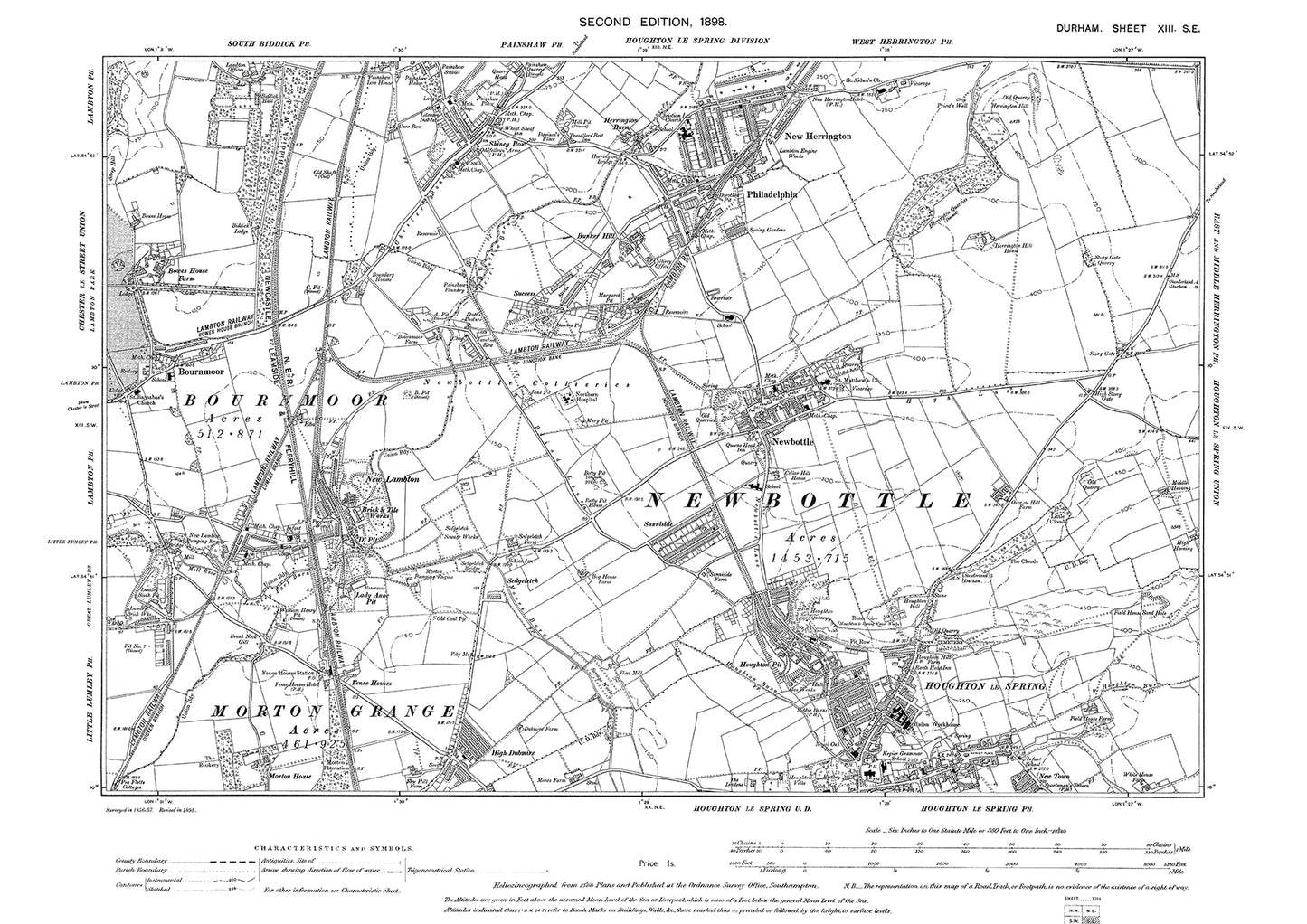Elite Wall Decor
Old OS map dated 1898, showing Houghton le Spring, Newbottle and New Herrington in Durham - 13SE
Old OS map dated 1898, showing Houghton le Spring, Newbottle and New Herrington in Durham - 13SE
Couldn't load pickup availability
This digital download is a high-quality 300 dpi JPG image of a 1:10560 scale (6 inches to the mile) Ordnance Survey map sized to A2 dimensions (59.4 cm x 42 cm or 7016 x 4961 pixels), making it perfect for viewing on your PC/Laptop using image software such as Photoshop or Gimp, or utilities such as Windows Photo or Windows Paint. Print at home if required, or use an online or local printing service.
The map provides a detailed view of an area measuring 2 x 3 miles, where six inches on the map is equivalent to one mile. It shows (where present) buildings, roads, railways, mines, quarries, wells water pumps, benchmarks, allotments, sports grounds, factories, mills and many other features, some of which are named. It also includes contours and spot heights, which provide information about the elevation of the terrain.
Houghton le Spring:
Houghton le Spring is a historic town located in the City of Sunderland, County Durham. It has a long and fascinating history that dates back centuries.
The origins of Houghton le Spring can be traced back to the Anglo-Saxon era. The town grew around the presence of a monastery, founded in the 12th century by the Benedictine monks. The monastery played a significant role in the town's early development and brought religious and economic influence to the area.
During the medieval period, Houghton le Spring became known for its agricultural activities, with farming and the production of local goods driving the local economy. The town's strategic location on the road between Durham and Sunderland also contributed to its growth and importance as a market center.
In the 19th century, the industrial revolution had a transformative impact on Houghton le Spring. The town's coal reserves attracted mining operations, leading to the establishment of numerous collieries. The coal mining industry became the backbone of the local economy and brought prosperity to the town.
Houghton le Spring experienced further growth and development in the 20th century, with the expansion of industries such as engineering, printing, and manufacturing. The town became an important center for commerce and employment.
Today, Houghton le Spring is a vibrant town that blends its rich history with modern amenities. The town's historical landmarks, including the ancient parish church and the remains of the monastery, attract visitors interested in its heritage. Houghton le Spring continues to evolve, adapting to the changing times while preserving its historical character.
Newbottle:
Newbottle is a village located near Houghton le Spring in County Durham. The village has a history that revolves around agriculture, mining, and the local community.
Historically, Newbottle was primarily an agricultural community, with farming as the main source of livelihood for its residents. The fertile land surrounding the village supported the cultivation of crops and the rearing of livestock.
In the 19th century, the discovery of coal reserves in the area led to the establishment of collieries near Newbottle. The mining industry brought changes to the village, attracting workers and contributing to its growth.
The mining operations in Newbottle created employment opportunities and contributed to the local economy. The collieries played a crucial role in the industrial development of the region and fueled the growth of neighboring towns and villages.
However, like many other areas in County Durham, the decline of the coal mining industry in the latter part of the 20th century had a significant impact on Newbottle. The closure of collieries resulted in job losses and brought about economic challenges for the village and its residents.
New Herrington:
New Herrington is a village located near Houghton le Spring in County Durham, England. Its history is closely tied to the coal mining industry and the development of mining communities in the region.
New Herrington's history can be traced back to the 19th century when the village was established to accommodate the growing number of workers in the local coal mines. The village was built around the collieries, which provided employment opportunities for the residents.
The coal mining industry played a crucial role in shaping New Herrington's development. The village grew rapidly as mining operations expanded, with the construction of housing, schools, and other community facilities to support the mining community.
The residents of New Herrington formed a close-knit and self-sufficient community, with social and recreational activities centered around the village. They shared a strong sense of camaraderie and solidarity, often participating in events and organizations that promoted community cohesion.
The coal mined in New Herrington and the surrounding areas was of high quality and in high demand during the industrial revolution. The coal mines fueled the growth of the region, providing fuel for industries, heating for homes, and contributing to the local and national economy.
However, like many other mining communities, New Herrington faced challenges with the decline of the coal mining industry in the latter part of the 20th century. The closure of collieries resulted in job losses and brought about changes to the local economy and community dynamics.

